[et_pb_section admin_label=”section”]
[et_pb_row admin_label=”row”]
[et_pb_column type=”4_4″][et_pb_text admin_label=”Text”]This article introduces a series of commentaries on metacognitive peer tutoring, each of which will offer useful insights into why students struggle and where they encounter problems in their learning routines. Also provided in each article will be innovative strategies and tactics to improve student learning and performance. You definitely want to follow this blog so you can be notified of each article in the series. What can be gleaned from analyzing two years of metacognitive tutoring documentation reports?
- Invaluable insights into students’ thinking,
- Rare windows into how students’ interpret tasks,
- Clearer understandings of how learners define roles and responsibilities in learning environments,
- Common themes for how students interact with content across a broad array of academic domains.
About the Data
The data behind this series consists of 522 documentation reports collected during the 2012-2014 academic years. During this period, more than 40 tutors working with 80+ students provided help in a wide range of disciplines. The tutoring sessions typically were one-hour events, and tutors saw students an average of six sessions (with some follow-up/check-up sessions). This article launches what I hope will foster dialog about metacognitive tutoring. For the past decade or so, I’ve been training tutors at Lenoir-Rhyne University in Hickory, NC, to incorporate metacognitive strategies in their tutoring sessions. Metacognition has been a useful construct and has helped us significantly improve the teaching and learning experience for students, student-athletes, tutors and faculty. In 2012, the National College Learning Center Association (NCLCA) awarded me the Brenda Pfaehler Professional Development Grant and encouraged me to develop a national metacognitive tutoring model. This honor provided me a rich opportunity to share the model with colleagues, and to build rewarding professional relationships with colleagues throughout the world.
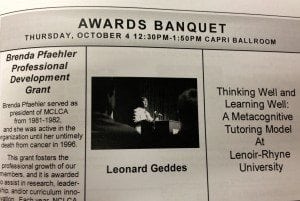
But what is metacognition? And why should I care about it?
In school, students are measured on how well they learn. Throughout the learning process, students exert their thinking skills on various academic tasks. If students think well, they learn well and perform well. However, if they think poorly, they learn insufficiently and their performance suffers. In either case, metacognition is key to improving performance. In the simplest terms, metacognition is thinking about one’s thinking. However, Taylor (1999) provides a particularly descriptive research definition: Metacognition is an appreciation of what one already knows, together with a correct apprehension of the learning task and what knowledge and skills it requires, combined with the agility to make correct inferences about how to apply one’s strategic knowledge to a particular situation and to do so efficiently and reliably. (1) I like to think of metacognition as the mechanics of thinking and learning. Students’ metacognitive functioning creates the conditions for how students will interact with content. Metacognition involves the levels and phases of interaction of one’s thinking as it intersects with the various tasks.
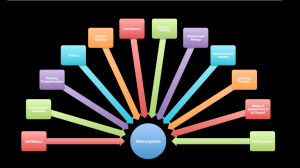
Metacognition operates on a continuum from awareness to control. It includes a planning, monitoring and evaluation phase. All students have some degree of metacognition; however, students differ on their degree of awareness and control. Metacognition makes the invisible process of interaction that occurs throughout learning more visible and concrete. As a result, students and helpers are less likely to misinterpret and misdiagnose learning problems and are more likely to significantly improve students’ thinking, learning and performance (in that exact order). Metacognition is relevant because researchers have linked metacognitive skills to an impressive array of performance measures and learning constructs. It’s safe to say that if there is one skill that can take students farther and faster toward becoming effective learners, metacognition is it.
Researchers have also noted the following:
- Short term, targeted interventions can produce long-term improvements in learning and performance.
- Metacognition has been correlated to academic performance in a wide variety of academic domains (e.g., sciences, history, math, nursing) and academic tasks (i.e., writing, research, reading comprehension, note taking).
- If students are able to think about a topic, then they are equipped to develop their metacognitive skills regarding the topic.
- Metacognition improves learning and performance of low, middle and high-performing students.
And what exactly is metacognitive tutoring?
 The learning experience consists of navigating information and cognitive functions from various settings. In each setting, students’ roles and responsibilities differ. Whereas traditional tutoring focuses on a particularly challenging subject area, and supplemental instruction addresses specific challenging courses, metacognitive tutoring focuses on students’ interaction with content, in general, across domains and academic tasks. We like to call it listening with a “third ear.” Metacognitive tutors address the immediate cognitive problems their students are experiencing while also remaining open to underlying metacognitive conditions that may be contributing to students’ academic problems. The primary goal of metacognitive tutoring is to move students from a current less desirable state of metacognitive functioning to a more desirable future state. The image below depicts various states of metacognitive functioning. In addition to traditional tutoring functions, the work of a metacognitive tutor involves the following operations:
The learning experience consists of navigating information and cognitive functions from various settings. In each setting, students’ roles and responsibilities differ. Whereas traditional tutoring focuses on a particularly challenging subject area, and supplemental instruction addresses specific challenging courses, metacognitive tutoring focuses on students’ interaction with content, in general, across domains and academic tasks. We like to call it listening with a “third ear.” Metacognitive tutors address the immediate cognitive problems their students are experiencing while also remaining open to underlying metacognitive conditions that may be contributing to students’ academic problems. The primary goal of metacognitive tutoring is to move students from a current less desirable state of metacognitive functioning to a more desirable future state. The image below depicts various states of metacognitive functioning. In addition to traditional tutoring functions, the work of a metacognitive tutor involves the following operations:
- Locating the Problem – Identifying the task, role, responsibility, setting or cognitive function that is the source of students’ problems.
- Clarifying the Problem – Distinguishing between students’ and faculty’s perceptions of the problems and the actual problems.
- Linking Metacognitive Roots – Connecting problems in students’ learning to their underlying metacognitive roots.
- Developing a Clear Metacognitive Problem-Solving Framework – Moving students from their “Now-State” to a more desirable “Goal-State.”
- Using Tools and Tactics – Using metacognitive tools and tactics to move students toward metacognitive control.
The image below shows the process in graphical form.
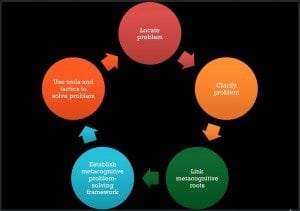
After analyzing years of tutor document logs, we developed a categorization system for locating students’ problems. Below is an image of the actual new documentation form we installed two years ago.
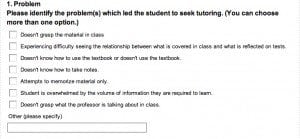
The bar graph below shows the categorical breakdown of responses from 2012-2014.
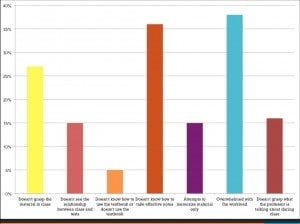
There is much more to the graph than meets the eye, so don’t make any solid conclusions. The picture evolves over time as problems are clarified. Locating and Clarifying the problem will be the focus of the next article. Talyor, S. (1999). Better learning through better thinking: Developing students’ metacognitive abilities. Journal of College Reading and Learning , 34-45.
[/et_pb_text][/et_pb_column]
[/et_pb_row]
[/et_pb_section]


8 comments
Holly Provost
Do you have this type of tutoring in the area of Nashua, NH?
Allison
I am excited to see how you will execute this program on the national level! -I tried to subscribe to this page using the image on the page (RSS feed), but it appears to be broken. Is there another/better way to follow the progress of this?
Thanks!
leonard.geddes@lr.edu
Allison,
It seems that RSS feeds work differently depending upon the user’s web browser. If you use Google Chrome, then you may get a message in XML code because Google Chrome wants to direct their users to Google Reader.
You can subscribe at: URL https://thelearnwellprojects.com/feed/.
Firefox and IE work as they use internal RSS reader with the ability to consume the XML to render a feed.
Please let me know if this resolves the problem. Thanks for your interest.
leonard.geddes@lr.edu
Allison,
Thanks for the confidence. Thanks for making me aware of the problem with the RSS feed. I have my guys looking at it. I will let add another comment when it is fixed.
Betty
Your thinking and research is definitely in line with AVID’s approach to Socratic Tutoring. Over the past 5 years, AVID’s secondary model has been adapted to work in higher education tutorial centers with great success. AVID for Higher Education’s model actually has a 6 step model that aligns with what you have. The extra step intentionally calls out using the tools and skills in content courses, not just in a peer tutoring process. The tools and skills are mutually reinforced to empower students to use these skills individually, in independent study groups and also when working with peer tutors in college tutoring centers. This inquiry process pushes students to identify what they know as they clarify their point of confusion and metacognition is the heartbeat of the process. I look forward to hearing more about your research project.
leonard.geddes@lr.edu
Hi Betty,
Thanks for your response. I wasn’t too familiar with the AVID until last year when I worked with a group of high school students in an AVID program. They really enjoyed the program and had solid results! In fact, I’ll be working with another group at the same high school this year. I would enjoy hearing more about AVID’s Socratic Tutoring approach.
Susan Wolcott
I look forward to hearing more about your research project in future blog postings and webinar! I’m also thinking about ways to create categories for student difficulties on assignments (rather than student requests for tutoring)–and how professors or others who are providing feedback on student work can encourage metacognitive development.
leonard.geddes@lr.edu
Susan,
Thanks for the post. This series will provide some very useful information for you. Feel free to share your work and insights as you read subsequent articles.